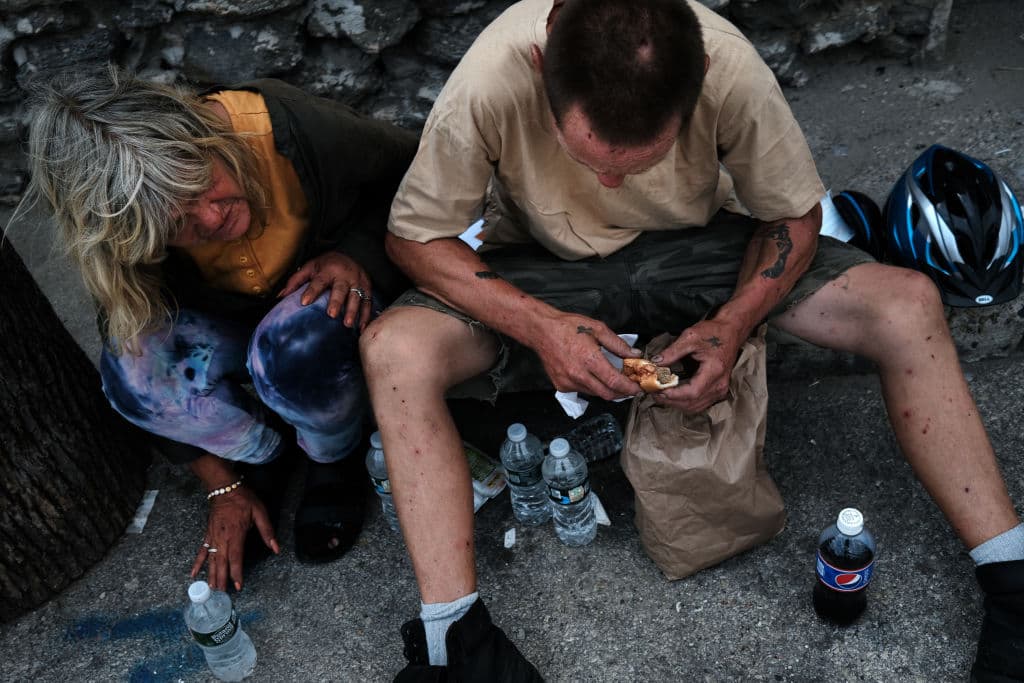State Lawmakers, Overwhelmed by Crime and Homelessness, Are Rethinking Liberal Policies About Public Drug Use
‘While we’re trying to employ harm reduction, we’re actually increasing the harm of long term generational drug addiction, mental illness, and homelessness,’ a retired DEA agent tells the Sun.

As states across the country grapple with surging overdose death and rampant public drug use, debate is emerging about whether harm reduction tactics currently in vogue among liberal advocacy groups live up to their name.
On the West Coast, an effort to end Oregon’s first-of-its-kind drug decriminalization law is taking shape, as lawmakers prepare for their legislative session beginning on February 5. The proposal would increase penalties for drug possession and public use, ending the state’s first-of-its-kind voter-enacted Measure 110 to decriminalize possession of hard drugs.
It’s the latest in the growing shift towards tougher-on-drug policies, as the Sun has been tracking, while cities bear the brunt of skyrocketing overdose deaths and growing homeless populations.
Yet, some states are pushing for increased “harm reduction” approaches, which advocates say saves lives by offering resources to drug users, increasing education, and preventing overdose deaths. Vermont’s House voted last week to approve a bill that would authorize safe injection sites, sending it to the state Senate for consideration. Massachusetts lawmakers are weighing similar legislation.
Some experts warn, however, that injection sites — and general decriminalization and tolerance of illicit drug use — enables addiction and negatively affects low-income neighborhoods.
A retired special agent of the Drug Enforcement Agency, Michael Brown, tells the Sun that there are many side effects of liberal harm reduction tactics.
“I agree with many aspects of harm reduction,” he says, but not progressive harm reduction, which he defines as “any acts which further enable the use of a dangerous substance, under the illusion that that danger can be successfully managed,” such as the “safe” injection sites in New York City.
New York City’s safe injection sites, the first in the country, don’t alter dangerous behavior, but rather, enable it, he says.
“You can go into this location, pull out your narcotics, use them, and if you overdose, there’s an administrator there to give you Narcan, bring you back to life and send you on your way,” Mr. Brown says. “So while we’re trying to employ harm reduction, we’re actually increasing the harm of long-term generational drug addiction, mental illness, and homelessness.”
Mr. Brown, who worked at the Drug Enforcement Administration for 32 years and is an expert in drug supply chains, says the safe houses for drug users and general progressive harm reduction policies can encourage dangerous cartels.
“Of course, if I’m in the Sinaloa Cartel, I’m looking at this policy, and I love it because I know that the individual that comes out of that house is going to come back to me immediately and buy more narcotics,” he says.
“So I’m going to increase my distribution of heroin, of methamphetamine, of fentanyl, because in places like New York, Colorado, Philadelphia, D.C, and San Francisco, I know nobody’s getting arrested,” he said, adding that those who are arrested are typically low level drug dealers or juveniles who get a summons.
Drug dealers can abuse the system by impoverishing minority communities, he noted.
“African Americans and Hispanics have a higher death rate with heroin and fentanyl than white Americans,” he said. “So there’s an equity issue that’s involved in harm reduction, that’s not looking at all the facts.”
People in the communities where safe injection sites are built suddenly have to deal with public defecation and homelessness, he says.
“These harm reduction locations, they’re not located in downtown Manhattan or on the Stock Exchange, they’re in low income communities of color,” Mr. Brown said, adding that it forces the taxpaying public to live under “horrid conditions.”
For staunch harm reduction advocates, “suddenly, the user is a victim. It’s not his or her fault. It’s the system’s fault for creating the conditions that forced them to become a drug addict,” he said. “So for everybody else, they’re paying the price.”

